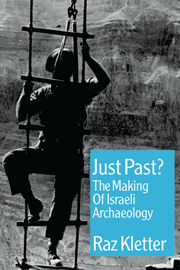Book contents
- Frontmatter
- Dedication
- Contents
- List of illustrations
- Introduction
- Acknowledgements
- Abbreviations
- 1 Archaeology and the 1948 War
- 2 Abandoned places, new places
- 3 Foreign aid
- 4 Frozen funds
- 5 A battalion of guards
- 6 Relief work
- 7 Man robs his land: “agreement” with General Dayan
- 8 “Gold of Ophir for Beth-Horon”: 3,000 shekels
- 9 The building beyond the border: the PAM, 1948–67
- 10 A building of dreams: a home for the IDAM and the origins of the Israel Museum, Jerusalem
- 11 A dead man on the council: the story of the supreme archaeological body in Israel
- 12 “But trust comes from the heart”: travels with the Government Tourist Corporation
- 13 “Whether in a courtyard of a synagogue, in a courtyard adjacent to a synagogue, or under a synagogue”: the Safad affair
- 14 The policy of salvage and early Israeli excavations
- 15 Myths and conclusions
- Appendix: other documents from the IDAM files
- Bibliography
- Author index
- Index
3 - Foreign aid
- Frontmatter
- Dedication
- Contents
- List of illustrations
- Introduction
- Acknowledgements
- Abbreviations
- 1 Archaeology and the 1948 War
- 2 Abandoned places, new places
- 3 Foreign aid
- 4 Frozen funds
- 5 A battalion of guards
- 6 Relief work
- 7 Man robs his land: “agreement” with General Dayan
- 8 “Gold of Ophir for Beth-Horon”: 3,000 shekels
- 9 The building beyond the border: the PAM, 1948–67
- 10 A building of dreams: a home for the IDAM and the origins of the Israel Museum, Jerusalem
- 11 A dead man on the council: the story of the supreme archaeological body in Israel
- 12 “But trust comes from the heart”: travels with the Government Tourist Corporation
- 13 “Whether in a courtyard of a synagogue, in a courtyard adjacent to a synagogue, or under a synagogue”: the Safad affair
- 14 The policy of salvage and early Israeli excavations
- 15 Myths and conclusions
- Appendix: other documents from the IDAM files
- Bibliography
- Author index
- Index
Summary
The Second World War stopped almost all excavation in Palestine, and the postwar situation did not permit the speedy recovery of archaeological enterprises in the Near East. The disintegration of the British Mandate in 1947–48 and the prolonged war halted foreign archaeological fieldwork in Palestine. Furthermore, most of the active archaeological institutions remained in East Jerusalem, so there were no foreign expeditions to Israel for a few years.
In March 1949 the Finnish scholar Aepeli Saarisalo (cf. Junkaala 1998), undeterred by the war, appeared in the offices of the IDAM and asked for permission to continue his survey of western Galilee. Not really ready for such a request, the IDAM suggested that he postpone the idea for several months, because of the danger of “Arab mines and of Arab militia groups from the rescue army of Qawuqji” (GL44864/14 no. 11).
The first foreign scholar to resume evacuations in Israel was René Neuville at Qiryat el-‘Anab (Kiryat Anavim) near Jerusalem in 1950. It was a small-scale project and he did not receive even an official excavation licence. Neuville, who died in 1952, was Consul General of France in Jerusalem (IEJ2(4) (1952): 255). In 1950, Jean Perrot excavated at Abu-Ghosh near Jerusalem and Gush Halav in Galilee. From 1952 the American School of Oriental Research initiated a fellowship in Israel (Alon4 (1953): 3).
- Type
- Chapter
- Information
- Just Past?The Making of Israeli Archaeology, pp. 82 - 89Publisher: Acumen PublishingPrint publication year: 2006



